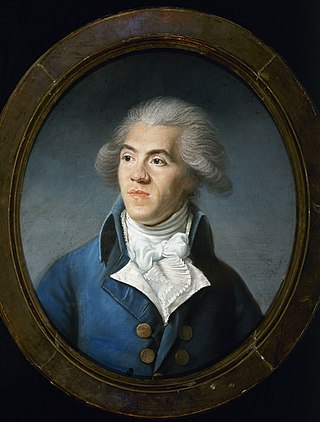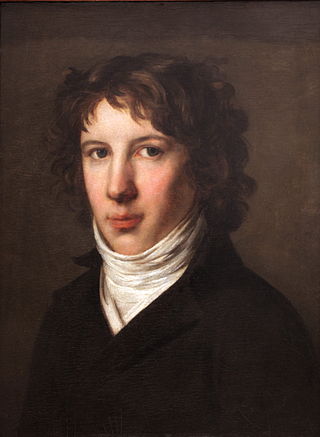Related Research Articles
A Jacobin was a member of the Jacobin Club, a revolutionary political movement that was the most famous political club during the French Revolution (1789–1799). The club got its name from meeting at the Dominican rue Saint-Honoré Monastery of the Jacobins. The Dominicans in France were called Jacobins because their first house in Paris was the Saint Jacques Monastery.

The Reign of Terror or the Mountain Republic was a period of the French Revolution when, following the creation of the First Republic, a series of massacres and numerous public executions took place in response to revolutionary fervour, anticlerical sentiment, and accusations of treason by the Committee of Public Safety. While terror was never formally instituted as a legal policy by the Convention, it was more often employed as a concept.

Georges Jacques Danton was a leading figure in the French Revolution. A modest and unknown lawyer on the eve of the Revolution, Danton became a famous orator of the Cordeliers Club and was raised to governmental responsibilities as the French Minister of Justice following the fall of the monarchy on the tenth of August 1792, and was allegedly responsible for inciting the September Massacres. He was tasked by the National Convention to intervene in the military conquest of Belgium led by French General Dumouriez. And in the Spring of 1793, he supported the foundation of a Revolutionary Tribunal and became the first president of the Committee of Public Safety.

Antoine Pierre Joseph Marie Barnave was a French politician, and, together with Honoré Mirabeau, one of the most influential orators of the early part of the French Revolution. He is most notable for correspondence with Marie Antoinette in an attempt to set up a constitutional monarchy and for being one of the founding members of the Feuillants.

The Committee of Public Safety was a committee of the National Convention which formed the provisional government and war cabinet during the Reign of Terror, a violent phase of the French Revolution. Supplementing the Committee of General Defence, created early January 1793, the Committee of Public Safety was created on 6 April 1793 by the National Convention. It was charged with protecting the new republic against its foreign and domestic enemies, fighting the First Coalition and the Vendée revolt. As a wartime measure, the committee was given broad supervisory and administrative powers over the armed forces, judiciary and legislature, as well as the executive bodies and ministers of the convention.

The Society of the Friends of the Constitution, renamed the Society of the Jacobins, Friends of Freedom and Equality after 1792 and commonly known as the Jacobin Club or simply the Jacobins, was the most influential political club during the French Revolution of 1789. The period of its political ascendancy includes the Reign of Terror, during which well over 10,000 people were put on trial and executed in France, many for political crimes.

Jacques Pierre Brissot, also known as Brissot de Warville was a French journalist, abolitionist, and revolutionary leading the faction of Girondins at the National Convention in Paris. The Girondins favored exporting the revolution and opposed a concentration of power in Paris. He collaborated on the Mercure de France and the Courier de l'Europe, which sympathized with the insurgents in the American colonies.
The Girondins, or Girondists, were a political group during the French Revolution. From 1791 to 1793, the Girondins were active in the Legislative Assembly and the National Convention. Together with the Montagnards, they initially were part of the Jacobin movement. They campaigned for the end of the monarchy, but then resisted the spiraling momentum of the Revolution, which caused a conflict with the more radical Montagnards. They dominated the movement until their fall in the insurrection of 31 May – 2 June 1793, which resulted in the domination of the Montagnards and the purge and eventual mass execution of the Girondins. This event is considered to mark the beginning of the Reign of Terror.

The Mountain was a political group during the French Revolution. Its members, called the Montagnards, sat on the highest benches in the National Convention. The term, first used during a session of the Legislative Assembly, came into general use in 1793. By the summer of 1793, that pair of opposed minority groups divided the National Convention. That year, the Montagnards were influential in what is commonly known as the Reign of Terror.

Louis Antoine Léon de Saint-Just, sometimes nicknamed the Archangel of Terror, was a French revolutionary, political philosopher, member and president of the French National Convention, a Jacobin club leader, and a major figure of the French Revolution. As the youngest member elected to the National Convention, Saint-Just belonged to the Mountain faction. A steadfast supporter and close friend of Robespierre, he was swept away in his downfall during 9th Thermidor.

The Committee of General Security was a parliamentary committee of the French National Convention which acted as police agency during the French Revolution. Established as a committee of the Convention in October 1792, it was designed to protect the Revolutionary Republic from internal enemies. Along with the Committee of Public Safety it oversaw the Reign of Terror. The Committee of General Security supervised the local police committees in charge of investigating reports of treason, and was one of the agencies with authority to refer suspects to the Revolutionary Tribunal for trial and possible execution by guillotine. In 1794 the committee was involved in the arrest and execution of Maximilien Robespierre and several of his political allies on 9 Thermidor. On 4 November 1795, along with the end of the National Convention, the Committee of General Security dissolved.

Augustin Bon Joseph de Robespierre, known as Robespierre the Younger, was a French lawyer, politician and the younger brother of French Revolutionary leader Maximilien Robespierre. His political views were similar to his brother's. When his brother was arrested on 9 Thermidor, Robespierre volunteered to be arrested as well, and he was executed by the guillotine along with Maximilien and 20 of his supporters.

Nesta Helen Webster was an English author who revived conspiracy theories about the Illuminati. She claimed that the secret society's members were occultists, plotting communist world domination, through a Jewish cabal, the Masons and Jesuits. She blamed the group for events including the French Revolution, 1848 Revolution, the First World War, and the Bolshevik Revolution. Her writing influenced later conspiracy theories and ideologies, including American anti-communism and the militia movement.

Maurice Duplay was a French carpentry contractor and revolutionary in the French Revolution. In September 1793 he became a member of the Revolutionary Tribunal. He was landlord to Maximilien de Robespierre, Charlotte Robespierre, Augustin Robespierre and Georges Couthon.

Maximilien François Marie Isidore de Robespierre was a French lawyer and statesman, widely recognized as one of the most influential and controversial figures of the French Revolution. Robespierre fervently campaigned for the voting rights of all men and their unimpeded admission to the National Guard. Additionally he advocated for the right to petition, the right to bear arms in self-defence, and the abolition of the Atlantic slave trade. He was a radical Jacobin leader who came to prominence as a member of the Committee of Public Safety, an administrative body of the First French Republic. His legacy has been heavily influenced by his actual or perceived participation in repression of the Revolution's opponents, but is notable for his progressive views for the time.
During the French Revolution the Constituent Assembly, elected in 1789, passed a self-denying ordinance barring any member from sitting in its successor, the Legislative Assembly convened in 1791.

The Coup d'état of 9 Thermidor or the Fall of Maximilien Robespierre is the series of events beginning with Maximilien Robespierre's address to the National Convention on 8 Thermidor Year II, his arrest the next day, and his execution on 10 Thermidor. In the speech of 8 Thermidor, Robespierre spoke of the existence of internal enemies, conspirators, and calumniators, within the Convention and the governing Committees. He refused to name them, which alarmed the deputies who feared Robespierre was preparing another purge of the Convention, similar to previous ones during the Reign of Terror.
Louis Félix Roux, was a French politician.
Observations on Maximilien Robespierre is a book about French revolutionary leader Maximilien Robespierre written and published in 1836 by Italian writer and conspirator Philippe Buonarroti.
References
- ↑ "Professor Marisa Linton". Kingston University. Archived from the original on 11 June 2020.
- ↑ Hamerton, Katharine (March 2005). "Marisa Linton, 'The Politics of Virtue in Enlightenment France'". The Journal of Modern History . 77 (1): 193–195. doi:10.1086/429449.
- ↑ Jainchill, Andrew (Winter 2008). "'Conspiracy in the French Revolution', edited by Peter R. Campbell, Thomas E. Kaiser, and Marisa Linton". Canadian Journal of History . 44 (3): 520. doi:10.3138/cjh.44.3.520.
- ↑ Andress, Dave (September 2013). "Choosing Terror: Virtue, Friendship and Authenticity in the French Revolution". Reviews in History. School of Advanced Study . Retrieved 20 March 2017.
- ↑ Mondon, Aurelien (2014). "Choosing Terror Virtue, Friendship, and Authenticity in the French Revolution". Modern & Contemporary France. 22 (3): 418–419. doi:10.1080/09639489.2014.883372. S2CID 145228028.